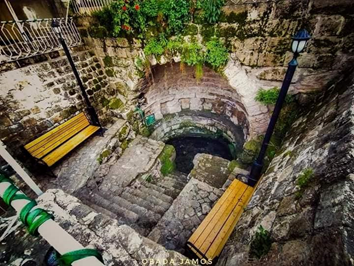The archaeological construction of the Besnada water spring is the edifice of the Nymphaeum in the Greek and Roman civilizations, which means in Arabic, “the path of the nymphs.”
It is a building dedicated to the sacred water, which is a small temple of the sacred nymphs, the demigods in the Roman civilization. In Greco-Roman civilization, the specializations of the nymphs varied, some were devoted to the virginity of forests and some to the sanctity of water. The symbolic meaning of these religious buildings dedicates reverence and thanksgiving to the spring of water that is the most powerful and life- giving to a region, including humans, animals, plants, and crops.
The Greeks and Romans built nymphaeum buildings in many places throughout their empire around the Mediterranean; In Italy, Greece, Syria, Egypt, and North Africa. In the east, there are famous examples of this building in both the Jordanian city of Jerash and the Syrian city of Qanawat.
The construction of the nymphaeum in Besnada, which was recently renovated by local and international bodies, is one of the rarest models on the Syrian coast. Popularly, people call such buildings Roman water springs, although the construction of the nymphaeum is very different from the Roman water houses known to people as water springs. There is a great difference between the Roman water house and the Roman path of nymphs. The first is a service building to protect the water, while the second, as in the case of the Nymphium of Besnada, is a small temple dedicated to the holiness of the water nymphs.
For thousands of years, the fresh water of Besnada’s spring has been flowing to give life to the around. It stems from a cave carved out of rock between two hills in the ancient village of Besnada east of Lattakia and descends from a height of about 100 meters of sea level.
The spring is characterized by the purity of its water, which comes through a stream from the springs of the Karm Al-Lawz area that are high above the spring. The visitor to the spring can see the water’s opening into the inner chamber of the spring, which was constructed seven meters below the surface of the earth and is entered through a staircase that reaches a semi-circular water basin built of carved stone. The spring receives its water from springs that gather in an inner section in the form of a rock-dug room.
There is a reservoir where the spring water gathers before it is distributed to water the adjacent orchards. The reservoir connects with the spring by an underground tunnel several meters deep constructed with carved stone.
The spring dates back to the Roman period and is registered archaeologically. It differs geometrically from the rest of the water springs by the exact design of its semi-circular dome, which was built of sculptural stone above the spring a long time ago, which appears to be a mixture of the Ugaritic, Roman, and Byzantine architecture.
Amal Farhat

